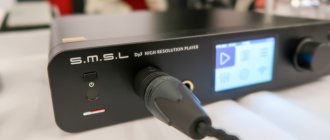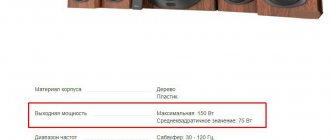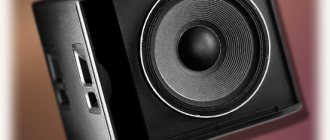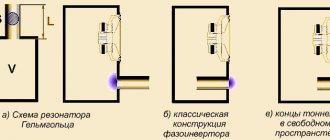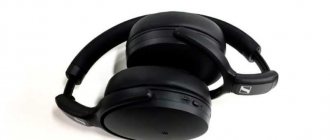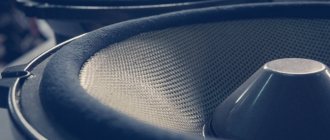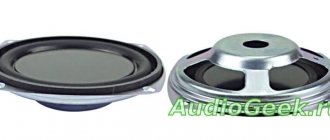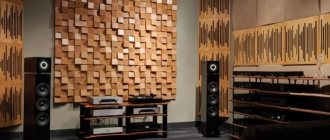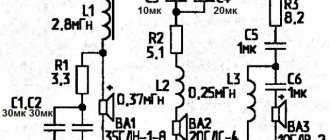Many people by the word power, in relation to speakers in colloquial speech, mean the strength or power of sound, perhaps this is true, but everything is relative to the plague. It is quite natural that when choosing a speaker system, the buyer determines the volume by power, for example - the higher the power, the louder and better the car speakers will sound. This well-known and widespread opinion is erroneous, why?, let's figure it out.
What is sound power and what should you pay attention to when buying speakers?
What is the WT designation
A speaker with a power of 100 Wt cannot always play better or louder than a speaker system with half the power, for example 50 Wt.
The power abbreviation WT does not primarily refer to the loudness of the speaker, but rather indicates the mechanical reliability of the acoustics as a whole or for each channel, and the indicated 50/100 Wt is not the loudness of the speaker at all. Acoustic heads themselves have low efficiency, converting only 2-3% of the power supplied to them from the electrical signal into sound vibrations (the volume of the sound produced, fortunately, is quite enough to create sound). The very indicated value in the form of Wt, which is indicated by the manufacturer of the speakers or acoustic system, only means that if the specified power is applied to the speaker, it will not fail, for example, critical heating of the interturn wire, the coil frame will not bite, or damage to the flexible speaker suspension, diffuser rupture, etc.
Considering the above, it can be understood that the power of the speakers or acoustic system is, first of all, a technical characteristic, and the indicated value in “Wt” is not the sound volume of the acoustic system, although it has some relation to it. Different power ratings of the speakers and its amplification path in the speaker system can be completely different. First of all, they are indicated for optimal switching and allow you to navigate between connecting components, for example, a power amplifier of significantly higher or significantly lower power can break the speaker cone or, more simply put, damage the speaker or acoustic system at the moment of the maximum position of the volume control: on the first - due to abnormal operation of the speaker, on the second - due to a high level of distortion.
Unique Features
To compensate for the low power of their audio system, modern TV manufacturers offer various unique features to improve sound. Many of them are absent in home theater audio systems and sound bars from the same manufacturers, so the functionality and unique features of such TVs are a significant advantage.
For example, some Samsung models offer:
LG does not lag behind its South Korean counterpart and offers its own set of features. Some of them repeat the features of competitors, some are unique:
Sony TVs also have their own technologies, here are some of them:
There are both similar and unique solutions for TVs from other manufacturers. All these features can seriously improve the sound and reduce the negative impact of an ultra-thin case and low-power speakers.
How to measure the reproduced power in speakers
Sound power can be measured in many different ways, and under different test conditions, there is a generally accepted standard for measuring the power of sound output from a speaker.
Let's take a closer look at some of the parameters that are often used in the characteristics of acoustic products:
Rated Maximum Sinusoidal power RMS - is the installed maximum sinusoidal power. The power itself can be measured by applying a sinusoidal signal with a frequency of “1000 Hz” until a critical level of nonlinear distortion is reached. Very often, in data sheets with product technical characteristics, this parameter is indicated as 25 W (RMS). This designation first of all says that the speakers, and the sound signal supplied to them with a power of 25 W, will be able to work for quite a long time, and will not receive any mechanical damage to the heads.
Compared to Hi-Fi speakers, the values for multimedia speakers are overestimated, the power indicated in Wt (RMS) comes primarily from measurements with very high harmonic distortion, up to approximately 10%. Listening to music or other sounds with such distortion is uncomfortable, the speakers begin to wheeze, and the dynamic heads in the housing begin to rattle.
Peak Music Power Output (PMPO) is the peak music output power. The power of this abbreviation is measured by applying a sinusoidal signal briefly and its duration is less than 1 second, and the frequency is below 250 Hz (usually 100 Hz), while the level of non-linear distortion is not taken into account, for example - the power of the speaker under the designation PMPO is equal to 500 W, this says We are informed that the acoustics did not suffer any mechanical damage to the heads during the playback of a short-term low-frequency signal. Such a unit of power measurement as W-PMPO is lovingly called “Chinese watt”, which allows using this technique to measure power up to a thousand Watts! For example, you have active computer speakers at home with an electrical power consumption of “10 V/A”, while the peak musical power of the PMPO is 1500 W (crazy!).
Russia has its own generally accepted standards for various types of power, namely GOST 16122-87 and GOST 23262-88.
Russian GOST defines such standardized concepts in acoustics as:
- Rated power
- maximum noise
- maximum sinusoidal
- maximum long-term
- maximum short-term power
Some of these parameters are indicated in the passport on Soviet or post-Soviet equipment. Unfortunately, world practice does not apply these standards, so for now we will not focus too much on GOSTs.
Therefore, it can be understood that an important indicator in practice, the power value of W RMS, is important for harmonic values THD = 1% or less. But it is worth noting the fact that the choice of sound products according to this technical characteristic is very approximate and may differ from reality; first of all, the volume of the reproduced sound has a sound pressure characteristic, as a result of which the information on the “speaker power” indicator is zero.
Content
When choosing a TV, the first thing you look at is the screen.
Manufacturers are trying to impress customers with ultra-high resolution, color quality, smart functionality and unique design. At the same time, built-in speakers are needed so that there is at least some sound until the user purchases a sound bar or multi-channel audio system. However, in recent years, models have begun to appear that boast a powerful built-in audio system with a subwoofer. According to the manufacturers, it will give a head start to many sound bars. Does such models make sense and is it worth paying extra for built-in sound? Since cinema ceased to be silent, the sound of the picture on the screen is taken for granted by the audience. When going to the cinema, the viewer sees a huge screen, but the speakers, no less impressive in size, are hidden from others, although they provide the lion's share of the wow effect from the viewing. Music, explosions, shooting, sound effects - they give weight and volume to what is happening on the screen.
Those who have tried to build a home theater in a single room know that the most investment and labor costs go into organizing multi-channel sound. Buying a huge screen and attaching it to the wall is not as difficult as making the acoustic preparation of the room, choosing speakers and an amplifier of the required power for it, coordinating everything so that nothing wheezes, and the house does not shake from the bass when there are explosions on the screen.
TV manufacturers, realizing that buyers would still connect external audio devices, most often did not bother with the quality sound of their devices. They can be understood: the buyer demands a model wider than a window and less than a finger thick. It is difficult to fit a high-quality audio system into such dimensions. Moreover, in recent years, soundbars have helped to organize good sound - small and not so expensive (compared to 5.1 and 7.1 systems) devices that provide multi-channel sound in any apartment without fussing with sound insulation.
However, today the situation has begun to change. Directional sound technologies used in sound bars have begun to appear in televisions. Many of them even come with subwoofers and offer decent sound right out of the box. So is it worth buying a soundbar and even more so bothering with organizing a 5.1 system if there are ready-made solutions? What parameters should you use to choose TVs with good sound, what rooms are they suitable for, and what to expect from them in practice?
Speaker sensitivity
A technical parameter such as sensitivity is a value characterizing the intensity of sound pressure that a speaker develops at a distance of 1 meter at a signal frequency of 1000 Hz and a power of 1 W.
Typically, the sensitivity of speakers is measured in dB-decibels, relative audibility (zero sound pressure level = 2*10^-5 Pa). Sometimes the designation Sound Pressure Level (SPL) is used - this is the level of characteristic sensitivity. For brevity, the technical column of measurement units indicates “dB/W*m” or “dB/W^1/2*m”; it is important to understand that sensitivity is not a linear proportionality coefficient between the level of sound pressure, signal power and distance to the source . Most manufacturers indicate in the characteristics the sensitivity of dynamic heads, measurements of which were carried out under non-standard conditions.
In itself, a technical characteristic such as sensitivity plays an important role when developing and designing your own acoustic systems. If understanding the sensitivity of speakers is not clear to you, then when selecting multimedia acoustics for a computer or other household speakers, you can not pay any attention to it and not bother (and not all manufacturers indicate it).
Myth fifth. Power is the main parameter when choosing acoustics
To allow the sound to fully develop, volume is needed, as well as the power to provide it. But the mentioned distortions can greatly spoil the picture. Other important parameters are responsible for the purity of sound over the entire SPL range: frequency response, impedance matching, acoustic design, etc. Each of them affects perception in its own way. Do not forget that the room in which the speaker system is located also plays an important role. And the features of musical compositions also need to be taken into account, it’s not for nothing that equalizers exist. All these details together form a rich, rich sound.
Source
Amplitude-frequency response in speakers
Amplitude-frequency response (AFC) is a graph showing the difference in the amplitude of the input and output signal over the entire range of reproduced frequencies. The amplitude-frequency response is measured by applying a sinusoidal signal of constant amplitude with a change in its frequency. At the graphical point of 1000 Hz, the zero dB level is usually plotted vertically.
Frequency response - amplitude-frequency response
The most ideal option is considered to be one where the frequency response is presented as a straight line, but in reality such characteristics do not exist in speakers and acoustic systems. Particular attention should be paid to the magnitude of the unevenness, and the greater it is, the more nonlinear distortions in the sound timbre.
Manufacturers of various foreign companies usually prefer to designate the range of reproduced frequencies, which is a “squeeze” of the information of the amplitude-frequency characteristic and only boundary irregularities and frequencies are indicated. For example, the description says: “50 Hz - 16 kHz (±3 dB)”, this means that this speaker system has reliable sound in the range of 50 Hz - 16 kHz, and everything below 50 Hz and above 15 kHz increases unevenness distortions in the sound, while the frequency response acquires a sharp decline in characteristics, let's call it a “blockage”.
When the low-frequency (LF) level in the speakers decreases, it implies a loss of richness and richness of the bass sound, and an increase in the low-frequency region is heard in the form of buzzing and muttering if you connect one subwoofer without additional speakers. When low frequencies are cut off, the sound becomes dull and unclear. Increases in high frequencies are indicated by the presence and sometimes even annoying unpleasant hissing and whistling sounds. For example, in multimedia speakers the magnitude of the unevenness of the amplitude-frequency response is higher than in a Hi-Fi speaker system.
Even despite various advertising statements from manufacturers and indications in the technical specifications of a parameter such as “20 - 20000 Hz” (a designation for the theoretical limit of capabilities) should be read and assessed with a great deal of skepticism and divide this parameter by approximately 2. With these indicators, the manufacturer does not indicates the unevenness of the amplitude-frequency characteristic, which can have unimaginable values.
For example, low-frequency speakers with a characteristic “20 Hz - 20000 Hz” may not provide a more or less uniform characteristic even in the frequency range “100 Hz - 10000 Hz”, and it is impossible to compare frequency ranges with different unevenness at all.
Model rating
Let's look at some interesting models from different price ranges.
Budget models
| Model | Characteristics |
| Microlab M-1910 Acoustics 5.1 for $120, the Microlab company produces quite high-quality products in the lower and middle price segments. A total power of 45 W, a subwoofer with a bass reflex, the body is trimmed with plastic panels. Pros:
Cons: none found. | |
| SVEN HT-200 A budget model costing 80-90 dollars in an MDF case. The products of the manufacturer SVEN have been on the market for more than 15 years and in this price segment they have very good quality. The total speaker power is 60W. The declared range of reproduced frequencies is 40-22000 Hz. Pros:
Flaws:
| |
| Gemix HT-1050 Ultra budget 5.1 system for $70. She has plastic speakers and a subwoofer made of MDF. Claimed total power 60W. Pros:
Cons: the speakers do not have mounts for hanging on the wall. |
Average price range
| Model | Characteristics |
| Edifier R501T III 5.1 speakers from a well-known manufacturer of inexpensive speaker systems. The cost is about 170 dollars. Edifier has a fairly wide range of models. It began to actively develop in the domestic market about 10 years ago, during which time it managed to show itself quite well in terms of quality and reliability. Pros:
Disadvantages: there are no volume controls on the subwoofer, all settings can only be made using the remote control. | |
| F&D F5060X Large home theater speakers with a total power of 60W for $170-180. F&D products are often very similar to the SVEN brand. The quality of this manufacturer is quite good. This model supports Bluetooth for wireless music playback and has a built-in simple player. Pros:
Disadvantages: none found. | |
| Genius SW-HF 5.1 6000 Speakers for almost $200 will delight the owner with good surround sound. Total power - 100 W. Pros:
Flaws:
|
Premium models
| Model | Characteristics |
| Soundbar LG SJ5 Miniature and loud acoustics for TV. Its cost is 300 dollars. Looks quite stylish. Total power 120 W. Pros:
Disadvantages: slightly overpriced. | |
| Powerful M-Audio HCS-9950 MKIII system Your neighbors will experience the most emotions! Its declared power is 420 W. 5 speakers, 2 of them are tall floor-standing, stylish design, clear sound. The body is made of MDF, like most modern models. Pros:
Disadvantages: none found. | |
| Microlab H-600 Beautiful and powerful speaker system (270W) 5.1 system, with high front speakers and a good subwoofer. Cost about 400 dollars. Pros:
Disadvantages: with prolonged use, problems may occur with the control unit or remote control. |
Harmonic and nonlinear distortion factor
Harmonic coefficient (Kg). The acoustic system itself as a whole is a complex electroacoustic device that has a nonlinear amplification characteristic. The audio signal, after passing through all audio channels at the output, will necessarily have nonlinear distortion. Harmonic distortion is the most obvious and the most elementary in measurements.
Harmonic distortion (Hi) is distortion that is a multiple of the fundamental tone of the signals. Parasitic harmonics cause irreparable losses in sound and add a new distorted sound timbre to the sound spectrum. Harmonic distortion can be measured by applying a sinusoidal signal in the frequency range of “1000 Hz”. Using a special filter, excess harmonics are detected in the sound signal and their power is determined.
A coefficient is a dimensionless quantity. It is usually indicated either in decibels or as a percentage, and the coefficient is taken into account by the formula: [dB] = 20 log ([%]/100) and the higher the harmonic value coefficient, the worse the sound of the speaker.
The harmonic coefficient of acoustics largely depends on the power of the supplied signals. Therefore, for a more reasonable choice of speakers, it is necessary, if possible, to first calculate Kg, and then listen to the sound itself; the working position of the volume control should be 30 - 50%.
Encoding algorithms
Since the days of DVD and Blu-Ray, two audio encoding formats have been leading the way in home theater sound: Dolby Digital and DTS-HD in various guises. Their base variations encode 5.1-channel audio, while the advanced DTS:X and Dolby Atmos versions support 7.1 with overhead audio and speakers. There are holiwars on the Internet about what is better. On the one hand, DTX:X encodes at a higher bitrate and should, in theory, provide better audio quality. On the other hand, Dolby Atmos is a more advanced format that can provide better quality at a lower bitrate.
In the end, this is all more a matter of taste, but there is one caveat. Atmos has gained wider support, including on streaming services like Netflix and Amazon Prime Video, while DTS:X is more suitable for a dedicated audio system. It is not surprising that in modern TVs Dolby Digital, Dolby Atmos and various variations like Dolby Digital Plus, Dolby 5.1 Decoder can be found more often than DTS:X. As for soundbars, you can also often find Dolby Digital and Atmos in inexpensive models, but more advanced ones support the maximum possible formats.
Impedance and electrical resistance in speakers
The electrodynamic head in the speakers has a certain direct current resistance, depending on the length, thickness and material of the wiring in the coil (this resistance is also called reactive or resistive). At the moment the sound signal is supplied, which is in the form of alternating current, the resistance of the electrodynamic head will change depending on the frequency of the signals.
Impedance is a designation for the total electrical resistance to alternating current, measured in the frequency range of “1000 Hz”. Basically, speaker systems have an impedance of 4 / 6 / 8 Ohm.e
Resistance in car speakers
When choosing speakers, the indicated resistance value in the technical specifications (impedance) will not tell the buyer about the sound quality of the purchased audio product. This parameter is usually indicated in the specifications to make it possible to calculate and select the necessary additional equipment for the speakers, such as an amplifier. If the speaker has a lower impedance value than the amplifier's recommended value, the sound will have various distortions or short circuit protection may be triggered; if the impedance value is higher, the sound of the speakers will be much quieter.
Acoustics design and speaker housing
An important factor influencing the sound of speakers or an acoustic system is the design of the acoustics of the emitting speaker head itself (dynamic head). When developing and designing acoustic systems, manufacturers usually face problems in the form of choosing a design for acoustics, and there are more than a dozen different types.
The design of acoustics is divided into acoustically loaded and acoustically unloaded:
- In the first option, the vibration of the diffuser is limited by air elasticity and acoustic air resistance.
- The second design implies that the diffuser is limited only by the rigidity of the suspension.
Also, the design of acoustics can be divided into double and single acting systems:
- The double-action system generates sound from both surfaces of the diffuser (from the front side of the speaker and from the back).
- A single-action system characterizes the excitation of sounds moving towards the listener on only one side of the diffuser (the emission of sounds from the opposite side is neutralized by the design of the speaker).
Since the design of the acoustic speaker has practically no effect on the mid-frequency and high-frequency heads, we will try to consider the most common options for low-frequency acoustic design of the cabinet.
An acoustic design called a closed box (box) is widely used - it is a housing element with a speaker diffuser brought out and refers to a loaded acoustic design.
- Advantages of the case design: good amplitude-frequency and impulse characteristics.
- Disadvantages of the cabinet design: the efficiency is low and there is a great need for a powerful amplifier; it also has a high level of harmonic distortion.
Sound waves caused by vibrations of the opposite side (reverse) of the diffuser are usually used in the most common double-acting version using a bass reflex, for example, a bass reflex is a pipe of a certain diameter and length installed in a housing. The length and cross-section of the pipe (phase inverter) is calculated in such a way that at a certain frequency it creates oscillations of in-phase sound waves caused by the front side of the speaker diffuser.
The acoustic design “Box-resonator” has the widest application.
Tapered curled quarter-wave resonator
A different example from a box with a visible diffuser, the diffuser of the resonator box is located inside the structure itself, on the partition, and the speaker does not participate in the formation of the low-frequency spectrum. The internal diffuser only excites various sound vibrations of low frequencies, which further increase in relation to the volume in the space of the bass reflex, which plays the role of a resonant chamber.
- The main advantage of these design options is the high efficiency with a small subwoofer size.
- And the shortcomings manifest themselves in the deterioration of impulse and phase characteristics; the reproduced sound of the speaker quickly tires.
The best option when choosing speakers would be a speaker with a wooden case, medium size with a bass reflex, made in a closed circuit.
Woofer with wooden body, medium size and bass reflex
When choosing a low-frequency speaker (subwoofer), you should pay attention not to its sound volume (this parameter, even in fairly inexpensive options, usually has a sufficient margin), but to a more reliable range of all reproduced low frequencies. The most undesirable speakers are those with thin bodies or small sizes in terms of the quality of the reproduced sound.
